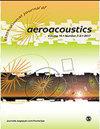Angle-of-attack and Mach number effects on the aeroacoustics of an SD7003 airfoil at Reynolds number 60,000
IF 1.3
4区 工程技术
Q3 ACOUSTICS
引用次数: 0
Abstract
The aeroacoustics of an SD7003 airfoil at Reynolds number 60,000 is investigated using Large Eddy Simulation. Five simulations are performed to study the effects of angle-of-attack and Mach number at fixed Reynolds number. For the three cases with angle-of-attack equal to 0° (M = 0.1, 0.3 and 0.6), a pure tonal noise associated with a 2D organisation of the flow is obtained. This flow topology is due to the establishment of a well known aeroacoustic feedback loop between the separation point on the suction side of the airfoil and the trailing edge. The occurrence of this loop is corroborated by the presence of a standing wave pattern with characteristic mode number in accordance with Panda’s model. The main effect of the Mach number is to promote flow separation and hence increase separation length and mode number. In addition, the first harmonic and the sub-harmonic of the tone, observed in the far field acoustic spectrum, are found to be generated in the wake, presumably due to non-linear vortex interactions. For the two other angles-of-attack 4° and 8° at M = 0.1, the feedback loop does not establish and a Laminar Separation Bubble (LSB) is observed. When increasing the angle-of-attack, the LSB shrinks with earlier reattachment. For those two cases, far-field spectra are characterized by a low frequency associated with the breathing motion of the LSB and the reattachment point fluctuating in space. The frequency of this fluctuation depends on the curvature of the bubble. Far-field spectra are also characterized by a broadband trailing edge noise whose frequency range decreases with the angle-of-attack. Again, this evolution is found to depend on the curvature of the bubble which may promote a centrifugal instability in the separated shear layer.攻角和马赫数对雷诺数为60000的SD7003翼型气动声学的影响
采用大涡模拟方法研究了60000雷诺数时SD7003型的气动声学特性。对固定雷诺数下攻角和马赫数的影响进行了5次仿真研究。对于攻角为0°的三种情况(M = 0.1, 0.3和0.6),可以获得与流的二维组织相关的纯音调噪声。这种流动拓扑是由于建立了一个众所周知的气动声学反馈回路之间的分离点在吸力侧的翼型和后缘。根据潘达的模型,存在一个具有特征模态数的驻波模式,证实了这一环路的存在。马赫数的主要作用是促进流动分离,从而增加分离长度和模态数。此外,在远场声谱中观察到的音调的一谐波和次谐波发现是在尾迹中产生的,可能是由于非线性涡旋相互作用。当M = 0.1时,另外两个攻角为4°和8°时,反馈回路不建立,并观察到层流分离泡(LSB)。当攻角增大时,LSB随着再附着时间的提前而收缩。对于这两种情况,远场光谱的特点是与LSB的呼吸运动和在空间中波动的再附着点有关的低频。这种波动的频率取决于气泡的曲率。远场频谱还具有宽带后缘噪声,其频率范围随迎角减小。同样,这种演变被发现取决于气泡的曲率,这可能会促进分离剪切层中的离心不稳定。
本文章由计算机程序翻译,如有差异,请以英文原文为准。
求助全文
约1分钟内获得全文
求助全文
来源期刊

International Journal of Aeroacoustics
ACOUSTICS-ENGINEERING, AEROSPACE
CiteScore
2.10
自引率
10.00%
发文量
38
审稿时长
>12 weeks
期刊介绍:
International Journal of Aeroacoustics is a peer-reviewed journal publishing developments in all areas of fundamental and applied aeroacoustics. Fundamental topics include advances in understanding aeroacoustics phenomena; applied topics include all aspects of civil and military aircraft, automobile and high speed train aeroacoustics, and the impact of acoustics on structures. As well as original contributions, state of the art reviews and surveys will be published.
Subtopics include, among others, jet mixing noise; screech tones; broadband shock associated noise and methods for suppression; the near-ground acoustic environment of Short Take-Off and Vertical Landing (STOVL) aircraft; weapons bay aeroacoustics, cavity acoustics, closed-loop feedback control of aeroacoustic phenomena; computational aeroacoustics including high fidelity numerical simulations, and analytical acoustics.
 求助内容:
求助内容: 应助结果提醒方式:
应助结果提醒方式:


